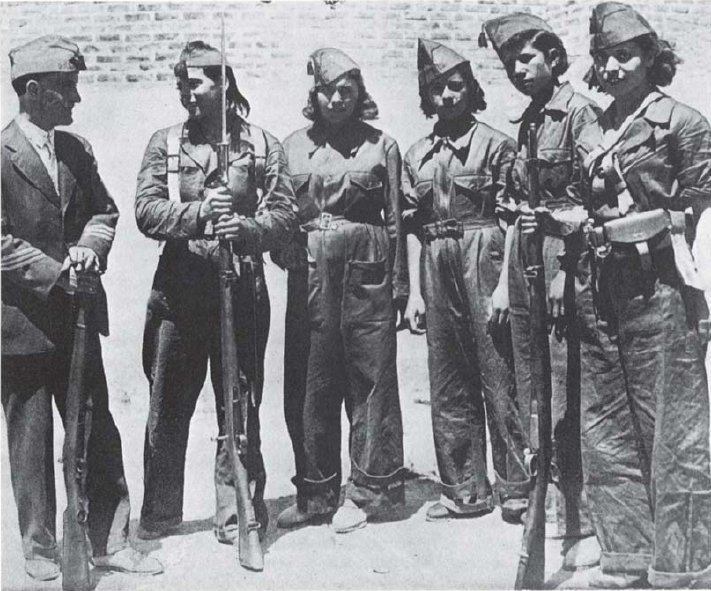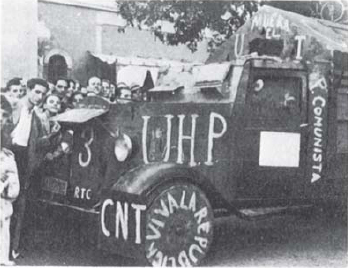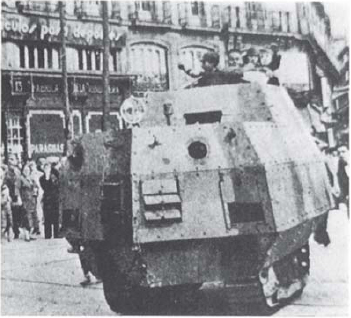
The main Nationalist striking force was the African Army stationed in Spanish Morocco. On 17 July, this army consisted of six banderas (battalions) of the Tercio, ten tabores (half battalions) of Regulares, native Moroccans officered by Spaniards, seven Spanish infantry battalions, six squadrons of Spanish cavalry, and six field artillery batteries—in all, 24,000 seasoned troops. In addition, the Moroccan governor of the zone, the Khalifa, once assured that the rebellion was anti-Communist, placed his Mehalla (para-military native gendarmerie) at Franco’s disposal to act as local garrisons, thus freeing the regular army for operations on the mainland.
The Regulares could be compared with the old British Indian Army or the French Tirailleurs Marocains. All the men were volunteers, recruited almost entirely from the Berber hill tribes; they were hardy and courageous though perhaps unimaginative—excellent fighting material when well-led by officers who had gained their confidence.

Milicianas receive basic instruction during the defence of Madrid. They wear the ubiquitous mono or overall, with Army caps and leather equipment. Their sergeant instructor, left, has NCO ranking sewn to a civilian jacket, and some kind of inscription embroidered on the front of his cap. (Keystone)
Founded in 1920 for service in Morocco, the Tercio was immediately blooded in the savage 1920–25 Riff War. Unlike its French counterpart, which officially allowed no Frenchmen to serve in the ranks, the Tercio included a bare 10 per cent of foreigners in its personnel. The idea of a Spanish Legion was the brain child of a fanatical ultra Right-wing officer, Colonel Millan Astray; he sought to create a corps of equally fanatical, dedicated soldiers from the bunch of misfits, social outcasts and petty criminals who were the first to sign on in the ‘Legion’. With the young Major Francisco Franco as his second-in-command, he achieved a considerable degree of success. Believing that death in battle was the highest honour and that ‘the Legionaries’ standard was the most glorious because it was dyed with the blood of the Legionaries’, they called themselves Los Novios de la Muerte (the Betrothed of Death). By 1936 the Legion had become an elite corps by any standards, and by the end of the war their numbers had been increased from six to eighteen banderas, and they had an armoured unit as well as a flame-thrower company.
To begin with, the Spanish army, both in Africa and on the mainland, was totally lacking in armour and was weak in artillery. This weakness dated back to 1926 when a group of senior artillery officers made a blundering attempt to stage a coup d’état. Little blood was spilled but, as a result, the infantry was ordered to take over all artillery barracks while the Spanish Royal Regiment of Artillery was declared ‘suspended and under arrest’. From then on, instead of being an independent and elite arm, the artillery was considered as a subsidiary service to the infantry.
Two groups of armed militia, the Falangists and Requetés, also rallied to the Nationalist flag, the traditional red and gold (Sangre y Oro) of monarchist Spain. Ideologically there was almost as wide a gulf separating these two groups as there was between Right and Left. Neo-Fascist, inclined to anti-clericalism, basically anti-monarchist, the Falange movement was founded in 1931 by two young intellectuals, Ramiro Ledesma Ramos and Onesimo Redonda Ortega as the J.O.N.S. (Juntas de Ofensiva Nacional Sindicalista). Their programme was based on a strange mixture of nationalist and anarchist ideals. Later the movement was taken over on more positive lines by José Antonio Primo de Rivera, son of the ex-Dictator, and a brilliant airman, Ruiz de Alda; it was renamed the Falange Español, and its programme was national, rather than international, socialism.

The Government had very few armoured vehicles in the early months of the war, and improvised armour of many kinds was pressed into service. This armoured truck is liberally decorated with political and trade-union slogans.
There was soon war between the blue-shirted Falange and the various extreme Left-wing militants. Between November 1933 and January 1934, eight Falangists were shot down by Communist gunmen. In March, the Falangists formed their own gangs of pistoleros. In October José Antonio, by then undisputed leader, claimed that his adherents numbered 40,000. Large numbers of Falange votes were polled at the February 1936 elections, and in April the government outlawed the party and arrested most of the leaders including José Antonio.
Until then the U.M.E. had viewed the Falange with suspicion, but its combat potential was at least making itself evident. Finally, it was at Franco’s suggestion that Colonel Yagué, then Jefe (Chief) of the Legion, was asked to act as liaison officer between the Army and the Falange. Though he was a rabid anti-Communist, he was a Republican at heart.
In marked ideological contrast were the Requetés, militant wing of the extreme Right-wing Carlists whose stronghold was the ultratraditionalist province of Navarre. Theirs was no modern political party. The Carlists had been in opposition to every government sitting in Madrid since 1833 when, on the death of Ferdinand VII, his infant daughter Isabella was proclaimed queen in defiance of the Salic law. Appalled at any digression from established tradition, the Navarrese supported the claims of Isabella’s uncle, Don Carlos, from then on styling themselves Carlists. In 1834 they started a bloody civil war which was to drag on for six years, and they repeated their insurrection in 1870.
Unlike the Falangists, the Carlists were ardent Catholics. In the 1930s their horror of anything that smacked of socialism led them to detest both Hitler and Mussolini as much as they abhorred Stalin. Indeed the Carlists who were represented in all strata of society had, by 1936, been preparing themselves actively for an anti-Republican war under the direction of their tough and able leader Fal Condé.
Their extremism made them difficult to integrate in any form of coalition. To begin with they would not admit that a non-Carlist could have honest intentions. Now, calling themselves the Comunión Tradicionalista, they demanded in return for their support, ‘absolute guarantees that the planned new State would be anti-democratic’. Even the staunch monarchist, General Mola, was heard to declare in a moment of exasperation, ‘The traditionalist movement is ruining Spain by its exigencies as surely as is the Popular Front!’ But, as late as 12 June 1936, Fal Condé was telling his followers they should ‘not second a movement that is not exclusively our own’. It was not in fact till 15 July that he finally agreed to call up his militia, the 8,400 strong Requetés, and to place them under the local army commander, and then only on the condition that his official letter of accordance be countersigned by the Carlist Pretender, Don Xavier de Borbón Parma.

Navarrese Carlist troops marching to the Bilbao front. The officer wears a sidecap and a mono of some kind, with the brass grenades of the artillery branch pinned to the collar points. The men wear red Carlist berets and light khaki clothing. In the right foreground are two sergeants, both wearing conventional Nationalist Army rank devices on their berets, and small ‘detente’ —Sacred Heart—badges on the left breast. (Keystone)

Another home-made Government ‘tank’–a heavy agricultural tractor with an improvised armoured superstructure, reminiscent of World War One in outline but of dubious effectiveness in combat.
Reaching a total of 42,000 at one period, the Requetés fought supremely well; together with the Tercio, they were usually assigned the toughest tasks. As a result their casualties were such that when hostilities ceased in April 1939 their overall strength had been reduced to 23,000.
Foreign aid to the Nationalists came principally from Germany and Italy. Generally speaking Mussolini supplied men known vaguely as the Corpo Truppo Volontarie; the Germans supplied material and specialists.
Shrewd in many ways, yet an abysmal judge of character, Mussolini had formed a poor opinion of the Spaniard as a fighting man, convincing himself that the Nationalists would be able to triumph only if they were backed by massive manpower aid from Italy. By January 1937, 35,000 Italians were in Spain under the command of General Mario Roatta, former head of Italian Military Intelligence, but Franco did not really welcome their presence. He was well aware that the Italians—the majority of them ‘Blackshirt’ Fascist militia rather than regulars—would be no match for Spanish units or the International Brigades. On the other hand he desperately needed the equipment that Italy could supply, of which the most important element was aircraft. Italian fighter and bomber units played an increasingly important part in the war, and Franco purchased Fiat CR.32 fighters in large numbers for his own squadrons.
The German contribution proved of the highest value. Hitler did not send infantry, but machines and instructors—particularly tanks and aircraft. The first contingent of what would become a powerful and balanced air force, the Legion Condor, comprised twenty transport/bombers and six biplane fighters which played a great part in the airlift of men and material from Africa to Spain. Thereafter the Legion was steadily increased to three squadrons of bombers, three of fighters, three reconnaissance squadrons, and six anti-aircraft batteries with signals elements and staff. Spanish pilots flew with Germans beside them until they were trained; then they took over the various aircraft as new types were sent for the German squadrons. (For a detailed account of the air war over Spain, see Christopher Shores, Spanish Civil War Air Forces, Osprey AIRWAR series.) The same process was followed on the ground. At least 120 PzKw I Ausf. A and B tanks were sent to Spain, the majority being handed over to German-trained Spanish crews when they went into action. Apart from aircrew, German manpower in Spain was minimal, and total casualties were only about 300; nevertheless the technical superiority of German equipment in most fields made a significant, though not decisive, contribution to Franco’s victory. (It should be remembered, however, that for long periods the Russian pilots and aircraft dominated the skies over the front, just as the T-26 tank proved superior on the ground—a bounty was offered for each T-26 captured, and by 1938 at least sixty were serving in Nationalist units.)
Generally speaking, the Nationalists had the better leaders; Franco himself was a sound strategist and tactician. Though not a man to take major risks, he would never allow himself to be diverted from his main objective, nor was he ever known to waver, let alone weaken, in the face of adversity. Calm, cool and collected, he was the antithesis of the ebullient Spaniard of popular imagination. Brave and talented Emilio Mola might have proved an eventual rival for Franco but for his untimely death in a flying accident in the summer of 1937. Other generals, and in particular Yague of the Tercio, José Iglesias Varela, who rose from bugler, Moscardo, hero of the Alcázar siege, the fire-eater Aranda, and Fidel Davila commanding the northern army after Mola’s death, were all capable of handling a major formation in the field, if not with outstanding brilliance, with a solid capability and steadfastness. The highly individual Queipo de Llano who staged and got away with such a brilliant coup de main in Sevilla was not of the same professional calibre. Lazy and overfond of the pleasures of the flesh, he soon made it clear that his ambition was to sit back in Sevilla, relaxing and resting on his laurels for the rest of the war, rather than to risk his person or reputation on the battlefield.